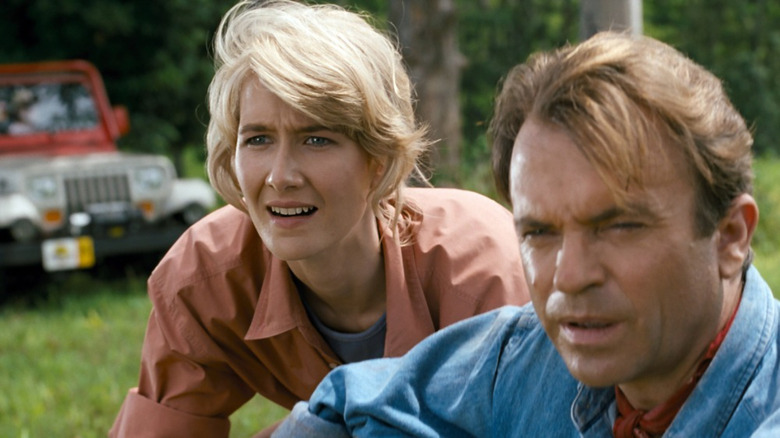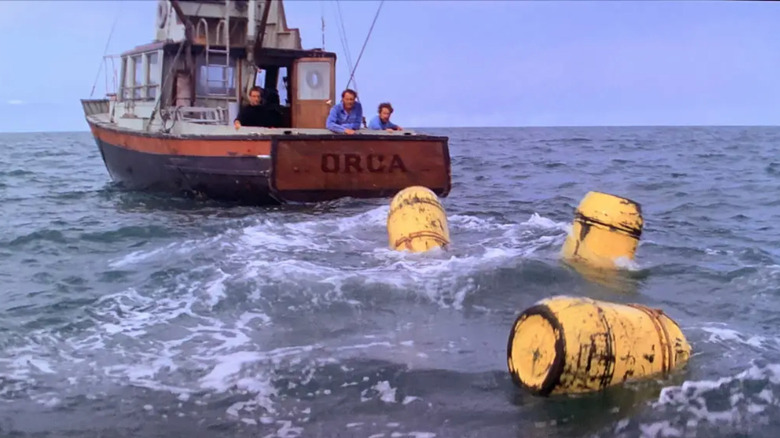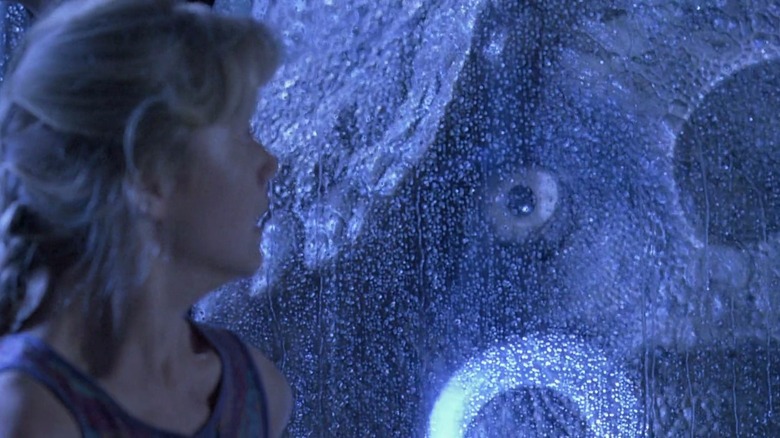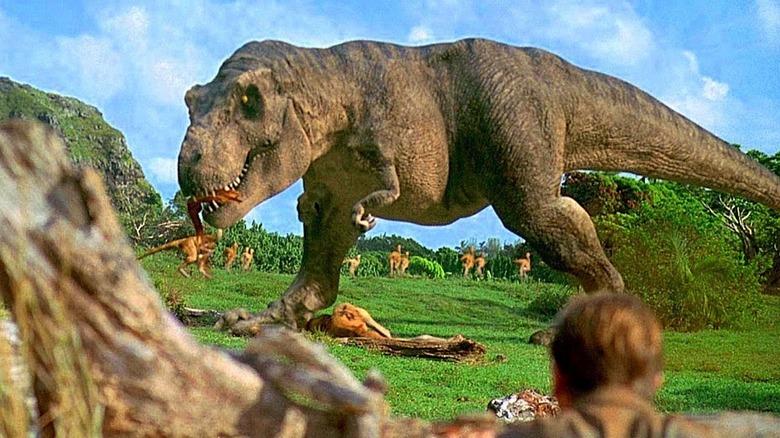Jurassic Park Took A Page From Jaws While Dealing With Dinosaur Footage
Out of all the methods and techniques of moviemaking discussed in film schools around the world, most of the lessons learned about filmmaking tend to get thrown out the window when shooting actually starts and problems start to inevitably sprout up. The best-laid plans often go astray, a telling turn of phrase that is especially true when the tiny catastrophes on a film set begin to mount. The difficult, arduous task of making a movie, big or small, has been chronicled in excruciating, often hilarious detail in 1995's "Living in Oblivion" and the Coen Brothers' "Hail Caesar" which follows the production woes of studio filmmaking in the 1950s. It's never easy to make a movie, but sometimes it seems downright impossible.
One of the greatest examples in Hollywood history of an unmitigated disaster becoming an unqualified masterpiece is undoubtedly Steven Spielberg's 1975 blockbuster "Jaws." The legendary difficulties that the then 26-year-old director faced during production out at sea in the unsympathetic Atlantic Ocean are covered in excruciating detail in the aptly named documentary "The Shark is Still Working." The mechanical failures and technical snafus brought filming to a standstill on multiple occasions, as the entire cast and crew waited for Special Mechanical Effects artist Roy Arbogast and his team to make sure Bruce the shark was ready for its close-up.
The longer the big bad of the film sat floundering in the water, the more Spielberg had to cut shots and reshape "Jaws" on the fly, forcing the panicking but extremely capable director to come up with creative ways to show that the shark was there even if it was never actually on screen. The result created a terrifying amount of tension, and taught Spielberg a valuable lesson that he carried over into his second big monster movie: "Jurassic Park."
Less is more
To be fair, it wasn't necessarily Bruce's fault that so many delays were taking place during filming. The animatronic shark was never properly tested in saltwater, and with Spielberg insisting that filming on "Jaws" had to take place in the Atlantic instead of an unrealistic water tank, mechanical failures were bound to happen. Thanks to the primal, hair-raising score by John Williams mixed with unsettling camera shots showing the shark's POV, the audience still felt the presence of a mammoth Great White without ever seeing it.
The scariest scene in "Jaws" may come early on during the Pier scene where two clueless fishermen hook their holiday roast to the dock, only to be pulled out to sea. A quick cut back to Chief Brody thumbing through a book filled with gruesome pictures of shark bites is a classic execution of the theater of the mind. A dorsal fin never even protrudes out of the water, but the audience feels that a shark attack is imminent.
Astoundingly, the great white shark (Carcharodon carcharias) in "Jaws," a film which runs for two hours and ten minutes, only has about four minutes of total screentime. There is some second-unit footage of a real great white that was filmed in Australia by legendary diver and conservationist Valerie Taylor and her husband, Ron, but other than that it's all good old-fashioned movie magic.
When it came time for Spielberg to bring dinosaurs to life in "Jurassic Park," the legendary director would trick the audience once again into believing they were seeing more of the prehistoric beasts than they actually were.
Show don't tell
There is one axiom that rules above all else in show business: show don't tell. For Spielberg and the effects artists tasked with bringing humans and dinosaurs together, it was crucial to show as little as possible while still achieving maximum impact. Similar to "Jaws," the actual scenes and sequences featuring a T-Rex, a Velociraptor, or another type of dinosaur, only amounted to about 15 minutes of total screentime, according to "Jurassic Park" crewmembers John Rosengrant and Matt Winston.
During production, Rosengrant and Winston were key artists responsible for operating the animatronic dinosaurs and puppets created by legendary make-up effects artist Stan Winston. In an interview with ABC News during their "20/20" 25th anniversary special looking back on the making of "Jurassic Park," Rosengrant spoke about Spielberg's less is more approach when it comes to selling the spectacular:
"It's taking that great philosophy of when you see it, it's amazing and you pepper it throughout the whole film, so you think you're seeing dinosaurs 24/7 but you actually don't. But when you do see them, they're top-notch and excellent."
Matt Winston also chimed in to compare what Spielberg learned during the production of "Jaws" and how he applied the same philosophy to "Jurassic Park" almost 20 years later. "In 'Jaws' there are very few shots of that shark and yet you're aware of the shark's presence throughout the film through music and other techniques he used, and he did that as well in 'Jurassic Park.'" Winston said. "There's a lot more dinosaur footage than there was shark footage, but still he used that technique of, 'It's over there, I can hear it breathing but I'm not necessarily seeing it.'"
The infamous T-Rex scene epitomizes Spielberg's patience as a filmmaker and his reliance on sound design and music to help build tension. When the severed goat leg is thrown up against the windshield, it's almost scarier than the eventual reveal of the ferocious Apex predator.
The sequels didn't stick with the formula
By the time the sequels to both franchises started coming down the pipeline, the philosophy that made both original films so effective was largely abandoned, in favor of more kills and thrills that eventually made seeing a great white or a dinosaur on screen a lot less appealing. The magic was gone, giving way to an overreliance on visual effects that was more about sheer spectacle instead of sparking the imagination of the audience.
The sequels to "Jaws" became more akin to a theme park slasher film once they entered into the decade of excess in the 1980s. And Spielberg himself even fell victim to the blockbuster formula he helped create when he directed the overstuffed sequel "The Lost World." By the time the "Jurassic World" sequels hit theaters, the classic beats and moments from the original were just being copied and pasted into a summer popcorn movie that made sure to have some kind of dinosaur in every corner of the frame.
"Jaws" and "Jurassic Park" will always be the gold standard when it comes to harrowing adventure films. But if we ever want to get back to what made them great, there needs to be a return to the minimalist approach that helped make both movies so effective in the first place. There's a reason why everyone remembers where they were in the summers of 1975 and 1993.



